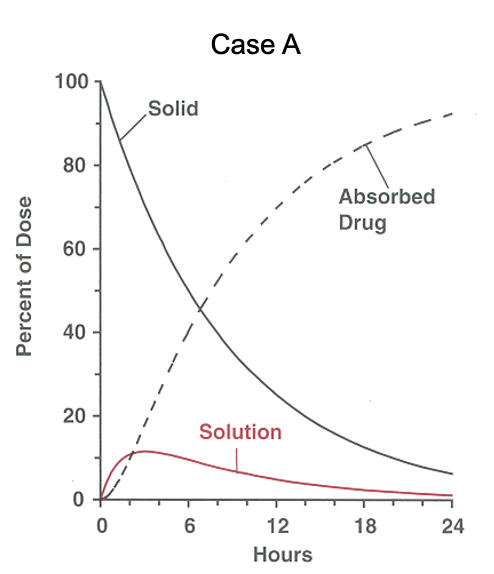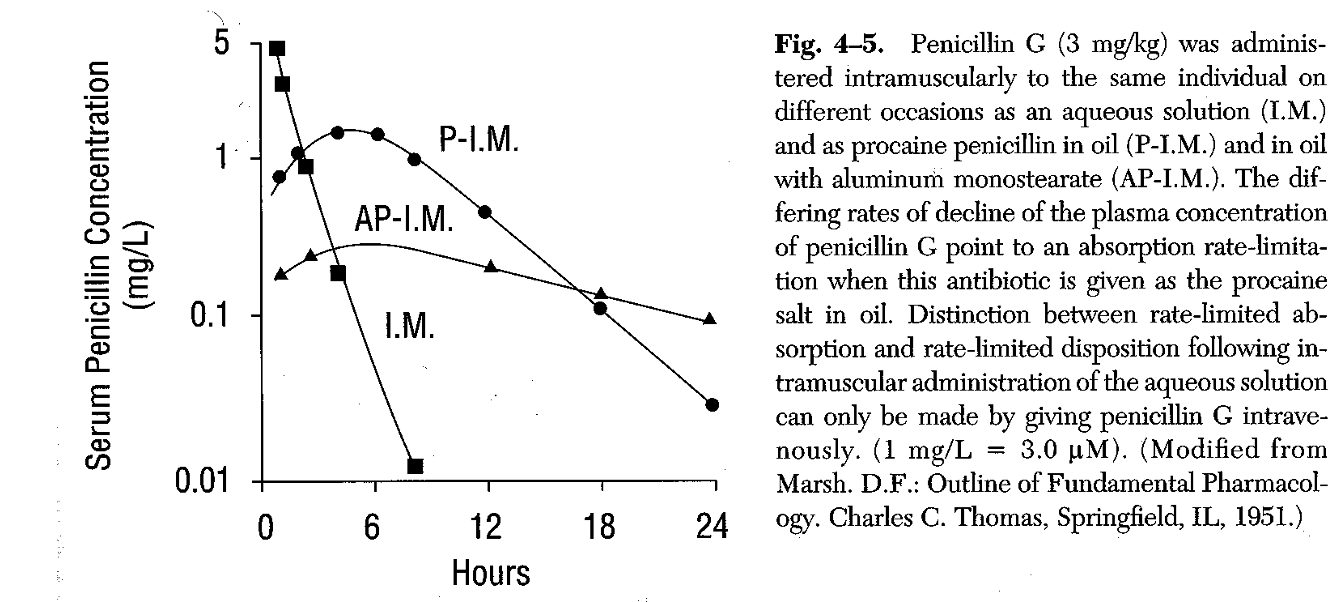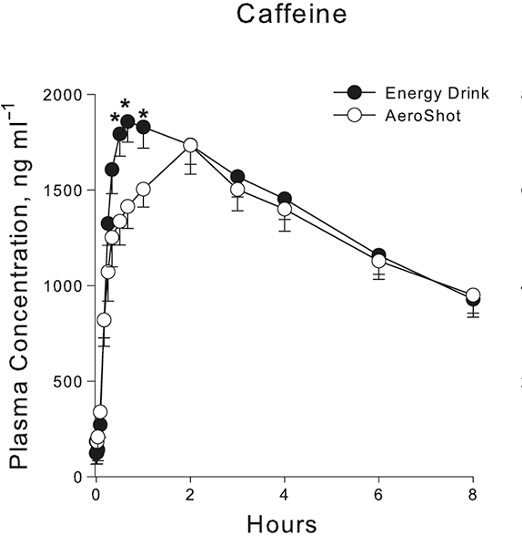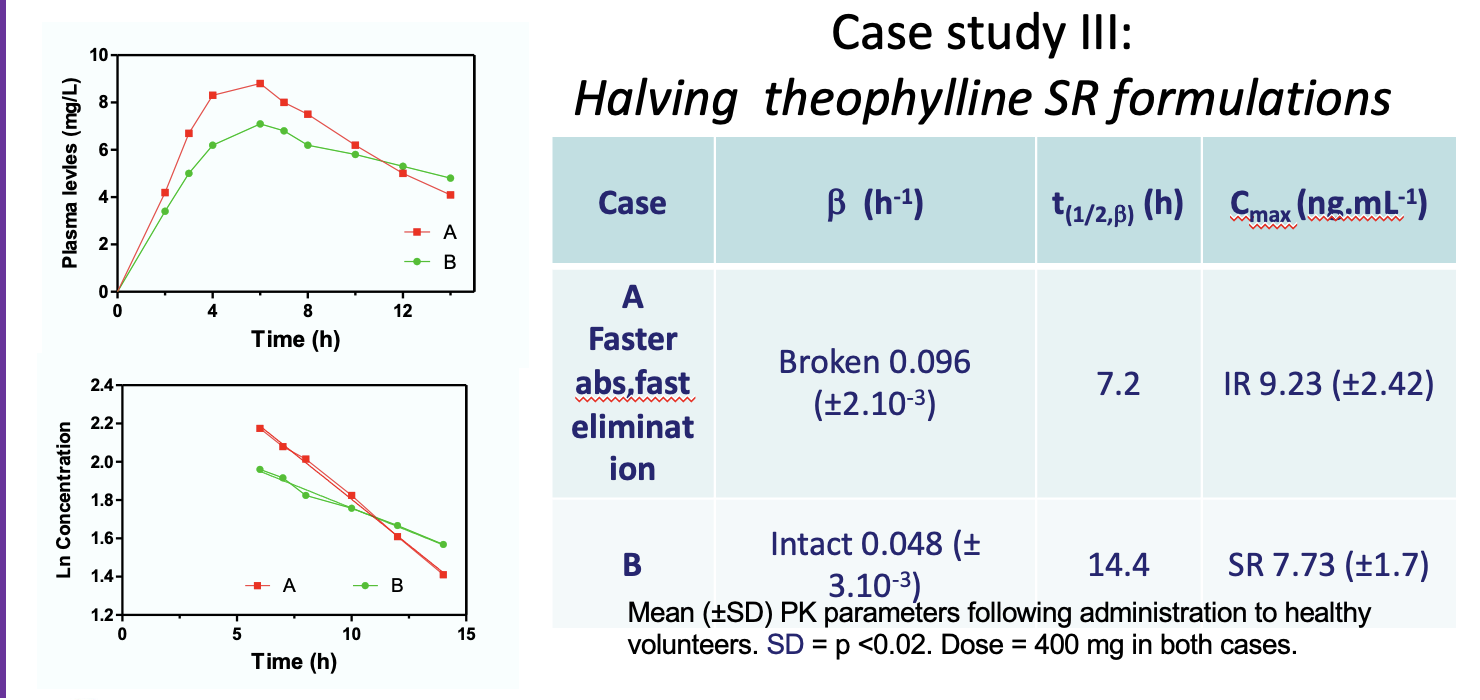Rate limiting processes
1/23
There's no tags or description
Looks like no tags are added yet.
Name | Mastery | Learn | Test | Matching | Spaced |
|---|
No study sessions yet.
24 Terms
Definition of the Rate-Limiting Step in a series of kinetic processes
The slowest step in the sequence of events. It determines the overall maximum rate of the complete process and imposes the upper limit on all subsequent steps.
Three main potential INPUT rate-limiting steps in extravascular drug administration
Dissolution (for solid dosage forms). How quickly the drug dissolves
2. Release (for modified-release formulations). How quickly the drug is released from its matrix
3. Absorption/Permeability (transport across the biological membrane, kabs).
Kinetics Case A: Conditions for Dissolution/Release Rate-Limited Absorption
Occurs when kdissolution or krelease << kabs.
The slow dissolution/release process controls the rate of drug input into the systemic circulation.
Can be beneficial for modifies/controlled/extended release

slope of graph of terminal curve
elimination rate constantH
How to identify Dissolution Rate-Limited kinetics experimentally
When we modify it leads to change in outcome
A change in dissolution rate (e.g., comparing drug in solid form versus solution) leads to a proportional change in the rate of absorption (Tmax changes significantly).
Kinetics Case B: Conditions for Permeability Rate-Limited Absorption
Occurs when kabs is slow compared to kdissolution and krelease. The transport across the membrane is the slow step, limiting systemic input.

Effect of modifying dissolution rate on Permeability Rate-Limited kinetics (Case B)
Modifying the dissolution/release rates has little to no effect on the overall rate of absorption, as membrane permeability (kabs) remains the bottleneck.
Kinetics Case C (General Case): Conditions for Disposition Rate-Limited Kinetics
Occurs when kabs >> kelimination (i.e., t1/2 abs << t1/2). Absorption is fast, and the elimination step controls the drug decline in the terminal phase.
t1/2
the time for half the drug to be absorbed
the shorter the half life the faster the process
Interpretation of the terminal phase slope (Slope=−β/2.303) in Disposition Rate-Limited Kinetics (Case C)
The slope reflects the elimination rate constant (k), meaning β=k. The terminal half-life (t1/2,β) equals the true elimination half-life (t1/2).
slope = -k/2.303
only depends clearance and volume
cl= k x v
What is flip flop kinetics
A phenomenon where the terminal slope of the ln(C) versus time plot reflects the absorption rate constant (kabs) rather than the elimination rate constant (k).
When does flip flop kinetics happen
Absorption is slower than elimination
Occurs when kabs << kelimination (i.e., t1/2 abs >> t1/2). The slow absorption process controls the decline of plasma concentration in the terminal phase.
THE SLOPE OF THIS GRAPH IS THE -K ABS NOT K
AS THE WHOLE THING IS RATE CONTROLLED BY ABSORPTION
Interpretation of the terminal phase slope (Slope=−β/2.303) in Flip-Flop Kinetics (Case D)
The slope reflects the absorption rate constant (kabs), meaning β=kabs. The terminal half-life (t1/2,β) equals the absorption half-life (t1/2,abs).
Key characteristic of the Cmax and elimination phase in Flip-Flop Kinetics
A considerable amount of drug remains at the absorption site when Cmax is reached. The drug is eliminated as fast as it is being absorbed.
Clinical/Formulation strategy used to induce Flip-Flop Kinetics
Designing a modified-release formulation (sustained, extended, controlled release) specifically to have a very slow release/absorption rate constant (kabs << k).
Therapeutic advantage of using Flip-Flop Kinetics in modified-release formulations
The slow absorption rate dictates the terminal plasma concentration decline, allowing plasma levels to be maintained longer, extending the duration of efficacy.
Method to definitively confirm Flip-Flop Kinetics in a drug product
Compare the terminal half-life (t1/2,β) from the extravascular product with the true elimination half-life (t1/2,elim) obtained from an IV Bolus or Infusion study.
Kinetics illustrated by Theophylline in Case Study I (Fig 4-4)
Disposition Rate-Limited Kinetics (Case C). Although absorption rate varied, the terminal half-life remained the same (6.3 hours), reflecting the true elimination rate (k).
Which case? Absorption- or disposition-controlled kinetics?
reasonable guess from properties, solubility, permeability, type of formulation
decided which step is controlling: dissolution, absorption, elimination
for exact value IV bolus is required
Kinetics observed for Procaine Penicillin in Oil (P-I.M.) in Case Study II (Fig 4-5)
Absorption Rate-Limited Kinetics (Flip-Flop, Case D). The slow, prolonged absorption of the procaine salt in oil dominates the terminal decline, giving a long t1/2,β that reflects kabs.
The fastest slope probably reflects the true rate of the drug but the others are the slow rate of absorption
ALWAYS FASTER ONE THAT IS THE ELIMINATION RATE CONSTANT

Conclusion on Caffeine kinetics (Energy Drink vs AeroShot) based on the terminal phase decline (Fig 2)
Since the terminal decline is identical for both formulations, the kinetics are Disposition Rate-Limited (Case C), reflecting the true elimination half-life of caffeine.

b
sloper of terminal phase
Identification of IR vs SR Oxprenolol formulations (Case Study III data)
IR: higher Cmax, larger peak, quick Tmax as drug is quickly released , lower K
SR: longer Tmax later, gets a lower peak reaches a lower Cmax, higher K

Theophylline SR
